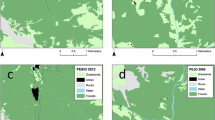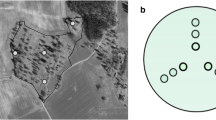Abstract
Fairy grass (Lachnagrostis filiformis) is an Australian native grass that has recently become a major concern for rural communities. Its dried inflorescences are blown by the wind and build up against fences and buildings, becoming a severe fire hazard. Understanding the ecology of fairy grass and its impacts on rural communities is relevant to its management. Four dry lake beds in Western Victoria were selected to determine if environmental factors, such as lake, location, direction, altitude and road type and the covariates of pH, soil salinity, soil moisture and distance to nearest road, are related to the presence of fairy grass. The ‘lake’ factor was the only environmental parameter that was significantly associated with the presence of this weed.







Similar content being viewed by others
References
Bauder ET, Snapp-Cook J, Sakrison J, Detwiler P (2002) A study on Agrostis avenaceae in vernal pools on marine corps air station Miraman, San Diego, California. Report commissioned by Marine Corps Air Station Miramar
Belyea LR, Lancaster J (1999) Assembly rules within a contingent ecology. Oikos 86:402–416
Benson D, McDougall L (2005) Ecology of Sydney plant species. Part 10. Monocotyledon families Lemnaceae to Zosteraceae. Cunninghamia 9:16–212
Bourke C (2000) Annual ryegrass toxicity and blown grass/beard grass poisoning. Agfact A0.9.4, New South Wales Department of Agriculture, NSW, Australia
Brower JE, Zar JH, Von Ende CN (1997) Field and laboratory methods for general ecology, 4th edn. Wm. C. Brown Publishers/McGraw Hill, Boston
Brown AJ, James EA (2000) Biodiversity and potential utilisation of blown-grasses (Agrostis spp.) in lowland Victoria. In: Proceedings of the 9th Australian Agronomy Conference, pp. 20–23 Victoria, Australia
Bryden WL, Irwin CE, Davis EO, Curran GL, Lean IJ, McKay AC, Edgar JA, Burgess LW (1998) Flood plain staggers: an intoxication in cattle due to the ingestion of blown grass (Agrostis avenacea) (abstract). Proc Nutr Soc Aust 16:240
Cabrera AL (1970) Gramineas. Flora de la Provincia de. B Aires 4:1–624
Carr G (2001) Australian plants as weeds in Victoria. Plant Prot Q 16:124–126
Carr G, Yugovic J, Robinson KE (1992) Environmental weeds invasions in Victoria: conservation and management implications. Department of Conservation and Environment, East Melbourne
Clarke PJ (2003) Composition of grazed and cleared temperate grassy woodlands in eastern Australia: patterns in space and inferences in time. J Veg Sci 14:5–14
Davidse GM, Sousa S, Knapp S (1998) Taxonomic and editorial changes made by the general editors to the Internet version of Flora Mesoamericana. Flora Mesoamericana, Versión de Internet (WFM).http://mobot.mobot.org/cgi-bin/search_vast
Douglas MM, O’Connor RA (2004) Weed invasion changes fuel characteristics: Para Grass (Urochloa mutica (Forssk.) T.Q. Nguyen) on a tropical floodplain. Ecol Manag Restor 5:143–145
Ejrnaes R, Bruun HH, Graae BJ (2005) Community assembly in experimental grasslands: suitable environment or timely arrival? Ecology 87:1225–1233
Florentine SK, Weller S, Graz FP, Westbrooke M, Florentine A, Javaid M, Fernando N, Chauhan BS, Dowling K (2016) Influence of selected environmental factors on seed germination and seedling survival of the arid zone invasive species tobacco bush (Nicotiana glauca R. Graham). Rangel J 38:417–425
Gaertner M, Breeyen AD, Hui C, Richardson DM (2009) Impacts of alien plant invasions on species richness in Mediterranean-type ecosystems: a meta-analysis. Prog Phys Geogr 33:319–338
Gibbs S (2000) How to texture soils and test for salinity. Salinity Note No 8 NSW Agriculture Viewed 16 April 2006. http://www.ricecrc.org/reader/salinity/salinitynote8.pdf?MIvalObj=7698&doctype=document&MItypeObj=application/pdf&name=/salinitynote8.pdf
Gibbs RGEW, Welman E, Reitief KL, Immelman G, Germishuizen PJ, Van Wyk PM, Nicholas A (1987) List of species of southern African plants. Mem Bot Surv S Afr 2:1–15
Gotelli NJ, Ellison AM (2002) Assembly rules for New England ant assemblages. Oikos 99:591–599
Groves RH (2001) Can Australian native plants be weeds? Plant Prot Q 16:114–117
Hitchcock AS (1971) Manual of grasses of the United States, 2nd edn. revised by a Chase Dover Publications, Inc., New York
Jacobs SWL (2001) The genus Lachnagrostis (Graminae) in Australia. Telopea 9:439–448
Kohnke JR, Kelleher F, Trevor-Jones P (1999) Feeding horses in Australia: a guide for horse owners and managers. RIRDC Pub. No. 99/49, Rural Industries Research and Development Corporation, Richmond, NSW, Australia
Mehrotra P, Kharakwl G, Pangety YPS (2004) Ecological implication of plant traits, strategies and competitive abilities of herbs. Appl Ecol Environ Res 2:1–13
Poussard H (2004) Management of Fairy Grass Lachnagrostis filiformis (previously Agrostis avenaceae) in the Wimmera and Ballarat areas. Preliminary Report to Department of Sustainability and Environment
Richardson DM, Kluge RL (2008) Seed banks of invasive Australian Acacia species in South Africa: role in invasiveness and options for management. Perspect Plant Ecol Evol Syst 10:161–177
Richardson DM, Van Wilgen BW, Mitchell DT (1987) Aspects of the reproductive ecology of four Australian Hakea species (Proteaceae) in South Africa. Oecologia 71:345–354
Schumacher WJ, Thill DC, Lee GA (1983) Allelopathic potential of wild oat (Avena fatua) on spring wheat (Triticum aestivum) growth. J Chem Ecol 9:1235–1245
USDA 2002 The plants database. http://plants.usda.gov/cgi_bin/topics.cgi
Warnock A (2010) Controlling Lachnagrostis filiformis (fairy grass) on dry lake beds in Western Victoria, Australia. PhD Thesis, University of Ballarat
Weiller CM, Henwood MJ, Lenz J, Watson L (1995) (Poaceae) in Australia—descriptions and illustrations
Whitehead M (2004) Risk assessment of fairy grass, Lachnagrostis filiformis, at Lake Burrumbeet. Department of Sustainability and Environment, Ballarat
Acknowledgements
We would like to thank Dr. Philippe Garrigues, Editor-in-Chief, Environmental and Pollution Science Research and two anonymous referees who provided constructive comments. Authors also would like to thank Cameron Hurst (Clinical Epidemiology and Biostatistics, Biostatistics Center of Excellence, Faculty of Medicine, Chulalongkorn University, Thailand, for providing statistical advice.
Author information
Authors and Affiliations
Corresponding author
Additional information
Responsible editor: Philippe Garrigues
Rights and permissions
About this article
Cite this article
Gosney, K., Florentine, S.K. Environmental factors associated with the foliage cover of invasive fairy grass (Lachnagrostis filiformis) in Victoria, Australia. Environ Sci Pollut Res 25, 1350–1358 (2018). https://doi.org/10.1007/s11356-017-0490-4
Received:
Accepted:
Published:
Issue Date:
DOI: https://doi.org/10.1007/s11356-017-0490-4




